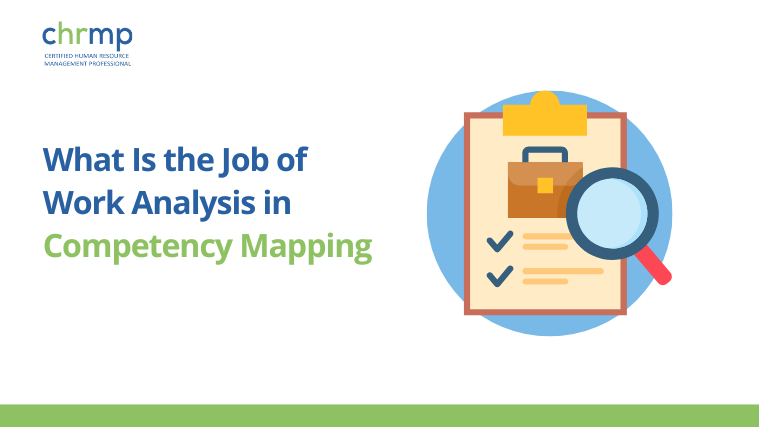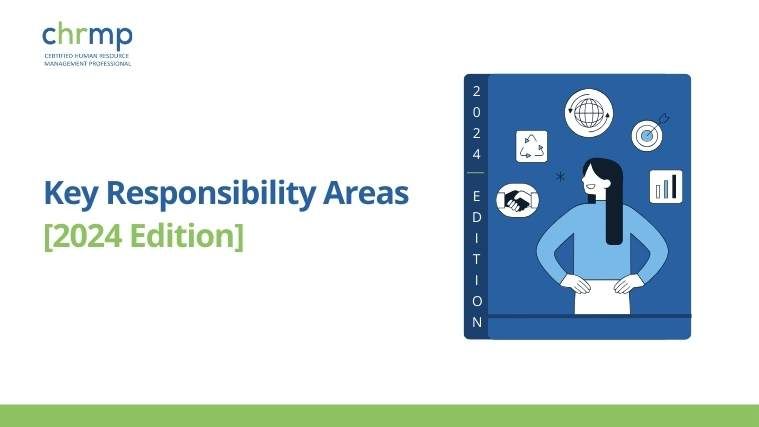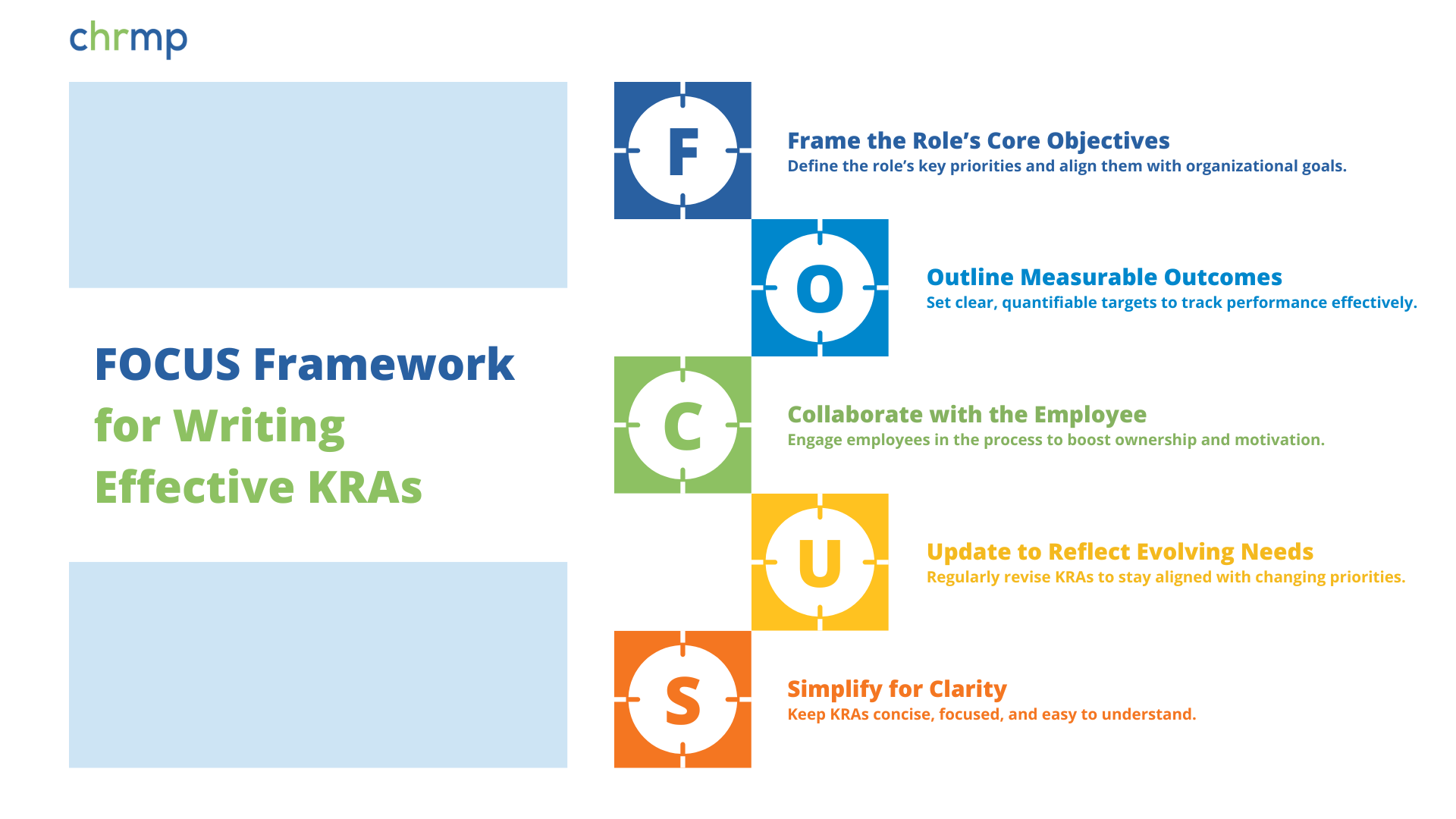

In today’s fast-paced work environment, role clarity is no longer optional—it’s a necessity. With businesses embracing remote work, cross-functional teams, and evolving roles, the importance of defining Key Responsibility Areas (KRAs) has never been greater. They are not just another HR buzzword; they are a strategic tool that ensures every individual in an organization knows their primary responsibilities and contributes effectively to business goals.
So, what are Key Responsibility Areas (KRAs)? At their core, KRAs define the critical functions and objectives an employee is expected to fulfill in their role. These areas outline the scope of accountability and focus, ensuring that employees prioritize what truly matters. In simpler terms, KRAs act as a bridge between individual performance and organizational success.
For example:
These clearly defined focus areas minimize confusion and help employees direct their efforts toward high-impact goals.
KRAs have come a long way. Traditionally, they were associated with rigid job descriptions in hierarchical setups. Over time, as workplaces became more dynamic and collaborative, KRAs evolved to reflect this change. In today’s hybrid and remote work models, KRAs are indispensable for keeping employees aligned and accountable, even when they’re spread across geographies.
For instance, in the past, a project manager’s KRA might have been limited to “overseeing project completion.” Now, it encompasses “coordinating across global teams, ensuring adherence to timelines, and driving agile processes.” This evolution ensures that KRAs remain relevant in modern workplaces.
Defining Key Responsibility Areas (KRAs) might seem straightforward, but it’s a delicate process that requires thoughtful planning and execution. When poorly defined, KRAs can lead to confusion, disengagement, and inefficiency. Let’s explore some of the common challenges, how they typically manifest, their Consequences, and how organizations can address them effectively.
The Challenge:
One of the most significant pitfalls in defining KRAs is ambiguity. When KRAs are too broad or vague, employees struggle to understand what’s expected of them. For instance, a KRA like “improve customer satisfaction” may leave employees wondering—how do I achieve this? What metrics will determine success? Ambiguity often shows up in the form of misaligned priorities. Employees may waste time on tasks they think are important but don’t contribute directly to the company’s goals. It also leads to frustration, as individuals feel uncertain about whether they are meeting expectations.
Consequences:
How to Mitigate It:
To overcome ambiguity, KRAs should be specific and measurable. Instead of saying “improve customer satisfaction,” reframe the KRA as “increase customer satisfaction scores from 80% to 90% by implementing feedback surveys and resolving complaints within 24 hours.” Collaborate with employees while drafting their KRAs to ensure clarity and alignment with team goals. Regular check-ins can also help refine KRAs if confusion persists.
The Challenge:
Another common issue is overloading employees with an excessive number of KRAs. While it’s tempting to assign a wide array of responsibilities to maximize output, this approach often backfires. Employees can only focus effectively on a few critical tasks. An employee with 10 KRAs might feel pulled in multiple directions, unable to give their best to any one area. This often leads to burnout, decreased quality of work, and unmet deadlines. Instead of fostering productivity, overloading KRAs overwhelms employees, leaving them feeling underappreciated and stressed.
Consequences:
How to Mitigate It:
Organizations should prioritize quality over quantity when defining KRAs. Focus on three to five high-impact areas that align with organizational goals. If an employee’s role requires multitasking, group related responsibilities into broader categories within the KRA. Leaders should also regularly assess workloads and redistribute tasks as needed to ensure employees aren’t overwhelmed.
The Challenge:
Roles evolve over time, especially in fast-paced industries. Yet, many organizations fail to update KRAs to reflect these changes. Employees may find themselves working on tasks that no longer align with the company’s priorities or that have been rendered redundant by automation or process changes. Outdated KRAs often appear when job descriptions and KRAs remain static, even as businesses innovate or pivot. For instance, a KRA focused on “managing paper records” in a company that has transitioned to digital documentation is not only irrelevant but also demotivating for the employee.
Consequences:
How to Mitigate It:
Review and refresh KRAs regularly—at least once a year or whenever there’s a significant shift in the business strategy. Conduct discussions with employees to understand how their roles have changed and what new challenges they face. Organizations can also invest in ongoing training to help employees adapt to these evolving responsibilities and see the value in their updated KRAs.
The Challenge:
Sometimes, KRAs are defined in isolation without considering how they contribute to broader organizational objectives. This misalignment can result in employees working hard but not necessarily working smart, as their efforts may not drive meaningful outcomes for the company. For instance, an employee in the marketing department might have a KRA to “publish three blog posts per week,” but if those posts don’t support the company’s strategic priorities, such as lead generation or brand awareness, the effort becomes misdirected.
Consequences:
How to Mitigate It:
Ensure KRAs are defined with a top-down approach. Begin by identifying organizational goals, then break them down into departmental objectives, and finally, individual KRAs. Communicate the “why” behind each KRA, so employees understand their role in the company’s success. Regular alignment meetings can also help recalibrate efforts when priorities shift.
The Challenge:
KRAs defined solely by managers without input from employees can feel imposed and irrelevant. Employees who have little say in shaping their KRAs may lack ownership and motivation to achieve them. Employees often feel disconnected from their KRAs, viewing them as arbitrary targets. For example, a customer service representative given a KRA to “upsell products” may feel frustrated if they weren’t consulted and believe it’s outside their skill set or primary job function.
Consequences:
How to Mitigate It:
Adopt a collaborative approach to defining KRAs. Involve employees in conversations about their roles and responsibilities, asking for their input on what they believe are their most critical contributions. This collaboration not only results in better-defined KRAs but also boosts morale and accountability.
At a mid-sized tech startup, developers and project managers frequently clashed over overlapping responsibilities, leading to delays in product releases. By introducing clear KRAs—such as “developers focus on writing and testing code” and “project managers oversee timelines and client communication”—the company improved team collaboration and reduced delivery times by 30%.
This example demonstrates how thoughtful KRAs can drive both individual and organizational efficiency.
When defining KRAs, collaboration is key. Employees who contribute to their KRAs are more likely to take ownership of their responsibilities. Here’s a tip: Schedule periodic check-ins to align KRAs with evolving business goals and individual career aspirations.
Key Responsibility Areas (KRAs) serve as a cornerstone for organizational success by defining the critical roles, responsibilities, and objectives that align individual efforts with the organization’s goals. They are essential for ensuring clarity, focus, and accountability in a workplace where distractions and overlapping duties can easily derail productivity. Below is a structured look at why KRAs are crucial, along with detailed explanations and relevant examples.
KRAs bring structure to roles by clearly defining what an employee is accountable for, eliminating ambiguity about job expectations. Without KRAs, employees may end up juggling tasks that are either unnecessary or outside their area of expertise, leading to inefficiencies and frustration.
Example:
Consider a marketing executive whose vague responsibility is to “manage digital marketing.” Without specifics, they might spend excessive time experimenting with various platforms without clear direction. However, if the KRA specifies “develop and execute three targeted digital campaigns per quarter to increase website traffic by 20%,” it provides a clear focus. The employee now understands what success looks like and can plan their time and resources accordingly.
When employees know exactly what is expected of them, they can prioritize their efforts on impactful tasks. This clarity reduces stress, enhances confidence, and leads to better individual and team performance.
KRAs provide employees with tangible, measurable goals that can be tracked and evaluated. They serve as a benchmark to assess performance objectively, ensuring fairness in evaluations and alignment with the organization’s goals.
Example:
A customer service representative may have a KRA that states, “Resolve 95% of customer complaints within 24 hours and maintain a customer satisfaction rating of 4.5/5.” This specific goal not only defines their responsibility but also offers clear metrics to gauge success. The representative can focus on resolving issues quickly while maintaining quality, and the manager can easily review their progress during performance appraisals.
Measurable KRAs create transparency and build trust between employees and managers. Employees can see how their efforts contribute to the organization and feel motivated by their tangible achievements.
KRAs help employees focus on high-priority tasks that have the greatest impact on organizational success. By reducing time spent on less critical activities, KRAs drive efficiency and ensure that employees contribute meaningfully to their teams.
Example:
An operations manager’s KRA might include “ensure a 10% reduction in operational costs by streamlining supply chain processes.” With this focus, the manager will prioritize analyzing vendor contracts, identifying cost-saving opportunities, and implementing automation where possible, instead of spending time on minor administrative tasks.
Focused KRAs eliminate distractions and provide a clear direction for employees, enabling them to achieve better results with fewer resources. Teams become more productive and aligned with strategic goals.
When KRAs are clearly defined, they create a sense of ownership and accountability. Each employee knows their responsibilities, reducing overlaps and confusion in team settings. KRAs also improve communication and foster collaboration by making individual roles within a team transparent.
Example:
In a product development team, a designer’s KRA might be “create three user-friendly prototypes based on client feedback within four weeks,” while the project manager’s KRA could be “ensure the team meets all milestones on time by coordinating tasks across departments.” These KRAs make it clear who is responsible for creative design and who oversees timelines, ensuring better coordination and minimizing misunderstandings.
When employees understand their unique contributions to a project, they take greater ownership of their work. This accountability builds trust within teams and ensures smoother, more efficient collaboration.
KRAs provide a structured framework for employees to understand their role in the organization and identify areas where they can improve. By setting clear expectations, KRAs also open up opportunities for employees to develop new skills and take on challenges that advance their careers.
Example:
An HR professional tasked with a KRA such as “implement a diversity and inclusion program to increase minority representation in the workforce by 15% within a year” will not only gain expertise in D&I strategies but also develop project management and stakeholder engagement skills. The experience positions them for future leadership roles in the organization.
KRAs guide employees in aligning their personal aspirations with organizational needs. This creates a win-win situation where the company benefits from enhanced capabilities, and employees feel valued and supported in their professional journey.

To craft impactful KRAs that drive clarity, accountability, and alignment, organizations need a structured approach. The FOCUS framework offers a simple yet powerful method to ensure KRAs are well-designed, meaningful, and effective.
Each letter in FOCUS stands for a critical step in the KRA development process:
What it Means:
Begin by identifying the essential purpose of the role. What are the top priorities or responsibilities this role must fulfill to contribute effectively to the organization’s goals? The KRA should capture these core objectives in a clear, concise manner.
How to Apply:
Example:
For a project manager: “Ensure on-time delivery of all assigned projects within the allocated budget.”
Framing objectives helps eliminate unnecessary details and ensures that the KRA is relevant and focused.
What it Means:
Each KRA must include clear metrics or outcomes that define success. This ensures the KRA is actionable and provides a way to measure progress objectively.
How to Apply:
Example:
For a marketing executive: “Increase social media engagement by 25% within six months through targeted campaigns.”
Outlining outcomes ensures clarity and allows for objective evaluation of performance, boosting motivation and accountability.
What it Means:
Creating KRAs shouldn’t be a top-down process. Involve the employee to ensure the KRAs are realistic, meaningful, and aligned with their strengths and aspirations.
How to Apply:
Example:
During a conversation with a customer service representative, they may suggest a KRA like, “Resolve 90% of customer complaints within 24 hours using the new support software.”
Collaboration fosters ownership and ensures that the KRAs are both relevant to the role and motivating for the employee.
What it Means:
KRAs should not be static. They need to evolve with changing business priorities, market dynamics, or shifts in the employee’s role. Regularly review and update KRAs to keep them relevant.
How to Apply:
Example:
An IT administrator’s KRA might shift from “ensure 99% system uptime” to “implement cloud solutions to reduce downtime by 30%” as the organization adopts new technology.
Updating KRAs ensures they remain aligned with both the employee’s growth and the organization’s changing needs.
What it Means:
KRAs should be straightforward and easy to understand. Overly complicated or jargon-heavy KRAs can lead to confusion and hinder execution.
How to Apply:
Example:
Instead of “Lead cross-functional initiatives to optimize supply chain performance through end-to-end visibility and data analytics,” simplify it to “Optimize supply chain processes to reduce lead times by 20%.”
Simplifying KRAs ensures that both employees and managers can easily interpret and act on them, leading to better focus and execution.
By applying the FOCUS framework, organizations can craft KRAs that are:
Ultimately, this framework empowers employees to perform with purpose and accountability while ensuring their contributions drive meaningful results for the organization. With FOCUS, creating impactful KRAs becomes a structured, collaborative, and outcome-driven process.
Key Responsibility Areas (KRAs) are a vital tool for aligning individual contributions with organizational objectives. They provide clarity, structure, and measurable outcomes for roles, ensuring that every employee knows their priorities and impact. Below are two detailed examples of how KRAs can be defined effectively for specific roles.
A mid-sized construction company, GreenBuild Solutions, had just secured its largest contract yet—a $2M renewable energy project to construct a state-of-the-art solar farm. This project was a strategic milestone, as it marked the company’s entry into the renewable energy sector, a move critical for its long-term growth. However, the company’s leadership had concerns due to their track record of delays in previous projects. They needed to ensure that this project was executed flawlessly to establish their credibility in the new market.
The project manager, assigned to lead this initiative, had to coordinate with multiple stakeholders, including engineering, procurement, and installation teams, while adhering to tight deadlines and budget constraints. To set the project manager up for success, the leadership team crafted precise KRAs to focus efforts on delivering measurable outcomes.
The KRAs for the project manager were as follows:
These KRAs ensured the project manager focused on the critical aspects of execution. By aligning individual objectives with the broader organizational goal of entering the renewable energy market, the KRAs drove accountability and clarity. The solar farm was delivered two weeks ahead of schedule, 8% under budget, and earned GreenBuild Solutions a prestigious industry award for execution excellence.
At Innovative Tech Solutions, an HR department faced significant challenges within the operations team. Productivity was declining, employee turnover had risen by 15% in the past year, and internal surveys revealed that team members felt undervalued and disconnected from leadership. These issues were exacerbated by a lack of mentorship opportunities and inconsistent feedback mechanisms, leaving employees uncertain about their growth prospects.
To address these challenges, the HR leader was tasked with creating a roadmap to improve team cohesion, engagement, and productivity. The leader’s KRAs were carefully designed to focus on building a supportive and high-performing team environment.
The KRAs for the HR leader included:
These KRAs provided the HR leader with a clear framework to address both individual and team-level concerns. By focusing on mentorship and feedback, the leader created an environment where employees felt supported and valued. Within a year, team productivity increased by 35%, and turnover dropped to an all-time low of 5%. The engagement survey results showed a 25% improvement in satisfaction, and several employees highlighted the mentorship program as a key factor in their career growth.
At Horizon Tech, a leading software company, customer churn had become a significant concern. Despite acquiring new clients at a steady pace, the company was losing long-term customers due to dissatisfaction with post-sales service and lack of consistent engagement. Recognizing the need to prioritize customer relationships, the sales team introduced KRAs focused on retention and relationship-building for their account executives.
One account executive’s KRAs were designed as follows:
With these KRAs in place, the account executive prioritized building trust and maintaining consistent communication with clients. Within six months, customer retention increased by 27%, and satisfaction scores improved by 18%. These customer-focused KRAs ensured clients felt valued and supported, fostering long-term loyalty and a stronger brand reputation for Horizon Tech.
At Global Logistics Corp, frequent delays in delivery schedules were causing disruptions and affecting client trust. The leadership identified inefficiencies in the supply chain as the root cause, including unclear workflows and bottlenecks in warehouse operations. To address this, they revamped the KRAs for the operations manager, aligning them with specific efficiency goals.
The KRAs for the operations manager were as follows:
Through these KRAs, the operations manager focused on improving communication between teams, investing in automated systems for tracking deliveries, and training warehouse staff to streamline processes. Over the next six months, delivery times decreased by 22%, and on-time dispatch accuracy improved to 97%. The company also achieved a 12% reduction in operational costs, far exceeding the initial target.
At Aurora Designs, a mid-sized e-commerce company specializing in sustainable home decor, the leadership noticed declining website traffic despite launching multiple campaigns. The marketing team identified a gap in their strategy—campaigns lacked focus and weren’t targeted toward audience engagement. To address this, the marketing lead’s KRAs were redesigned to align efforts with measurable outcomes and audience-driven strategies.
The marketing professional’s KRAs were defined as follows:
With these KRAs, the marketing professional focused on blending organic and paid strategies while staying data-driven. Within six months, website traffic increased by 50%, with 40% of this growth attributed to organic searches. Blog readership grew by 35%, and paid campaigns consistently outperformed benchmarks, boosting the company’s visibility and sales pipeline.
A tech startup, CodeNova, specializing in cloud software solutions, faced financial pressures in the highly competitive SaaS market. The sales department was tasked with boosting revenue to meet aggressive quarterly targets. To achieve this, the sales manager’s KRAs were rewritten to emphasize lead generation, strategic pipeline management, and team accountability.
The sales manager’s KRAs included:
Through these KRAs, the sales manager restructured the team’s approach to client engagement and implemented tools for tracking performance in real-time. By quarter’s end, CodeNova had exceeded its revenue targets by 17%, with individual team members achieving record sales figures. The revised KRAs ensured the entire team was aligned with the company’s growth goals, creating a culture of accountability and success.
At Innovexa Labs, a global technology firm, stagnation in the product development pipeline was threatening the company’s competitive edge. Management identified that the R&D team needed clearer priorities to focus on market-driven innovation. To address this, the team’s KRAs were carefully defined to encourage creativity while ensuring alignment with market needs.
The R&D team’s KRAs were structured as follows:
These KRAs provided the R&D team with a structured roadmap to foster creativity while remaining results-driven. Over the year, the team successfully launched three innovative products, two of which became top sellers in their categories within six months. This clear alignment of KRAs with market demands reinvigorated Innovexa Labs’ reputation for cutting-edge technology.
At BrightPath Solutions, a mid-sized IT services firm, employee turnover had reached 25% annually, threatening productivity and client satisfaction. Exit interviews revealed that employees felt undervalued, citing a lack of engagement initiatives and limited attention to well-being. To address this, the HR team’s KRAs were rewritten to focus on boosting engagement and retention.
The HR professional’s KRAs included:
By focusing on these KRAs, the HR professional developed a comprehensive engagement strategy. Within a year, turnover dropped to 18%, and satisfaction scores improved by 30%. Employees reported feeling more connected to the organization, creating a more positive workplace culture.
In the highly regulated pharmaceutical industry, BlueMed Pharma faced increasing scrutiny from regulatory authorities. A minor compliance breach had previously cost the company a significant fine, emphasizing the need for stricter adherence to industry standards. To address this, the compliance officer’s KRAs were tailored to focus on proactive risk mitigation and regular audits.
The compliance officer’s KRAs were defined as follows:
These KRAs ensured that compliance became a proactive priority. The company achieved 100% regulatory adherence over the next two years, passed all external audits without issues, and strengthened its reputation in the industry.
At MarketView Insights, a business intelligence firm, the leadership team was frustrated with the delays and inaccuracies in decision-making due to inconsistent reporting. The company’s business analyst was tasked with improving data quality and creating actionable insights to support strategic decisions. KRAs were defined to align the analyst’s responsibilities with organizational priorities.
The business analyst’s KRAs included:
By focusing on these KRAs, the analyst improved reporting efficiency by 25% and reduced decision-making time significantly. The insights provided enabled the leadership team to act swiftly on critical market opportunities, increasing the company’s competitive edge.
At GreenFuture Enterprises, an international consumer goods company, sustainability had become a critical focus due to growing pressure from stakeholders and regulatory bodies. The company’s leadership committed to reducing its carbon footprint, aligning with its Environmental, Social, and Governance (ESG) goals. KRAs were created for the sustainability officer to drive these initiatives effectively.
The sustainability officer’s KRAs were defined as follows:
Through these KRAs, GreenFuture Enterprises achieved a 12% reduction in carbon emissions within the first year, exceeding the initial target. Sustainable sourcing efforts also strengthened supplier relationships and reduced costs. The employee engagement program fostered a sense of collective responsibility, contributing to long-term value creation.
Key Responsibility Areas (KRAs) are a cornerstone of effective organizational management, providing employees with clear, measurable objectives that align their efforts with broader goals. From strategic planning and team leadership to customer engagement, operational efficiency, and beyond, well-defined KRAs help drive accountability, enhance productivity, and foster innovation. By focusing on specificity, collaboration, and alignment with organizational priorities, KRAs empower individuals to deliver meaningful results while creating a culture of purpose and performance. Whether addressing retention challenges, ensuring compliance, leveraging data, or advancing sustainability, KRAs serve as a powerful tool for achieving both individual and organizational success.

© 2007-2025 CHRMP| All Rights Reserved | Powered by Ripples Learning & Research Private Limited
